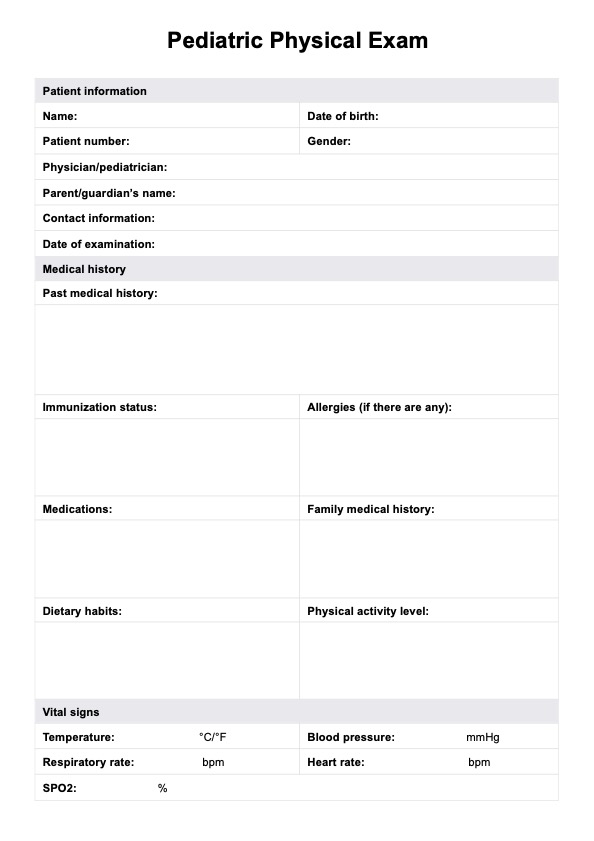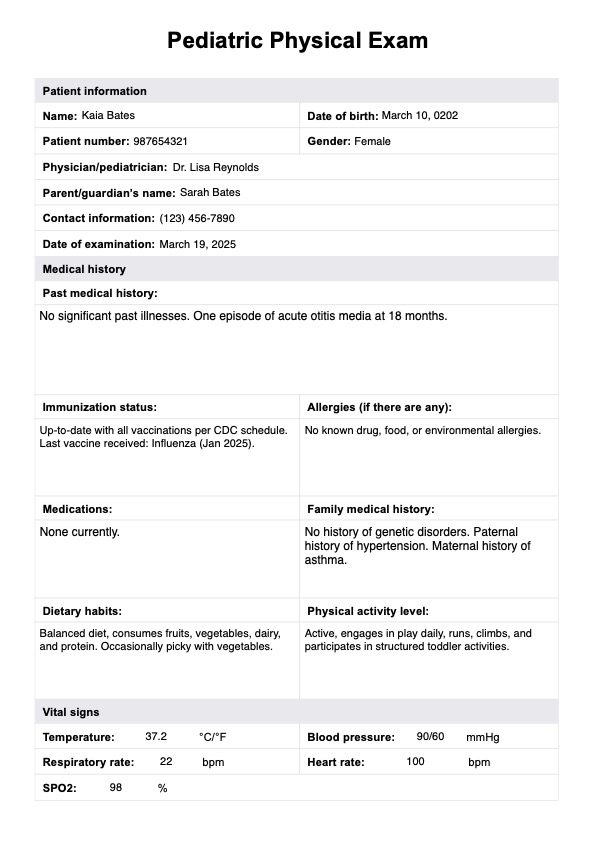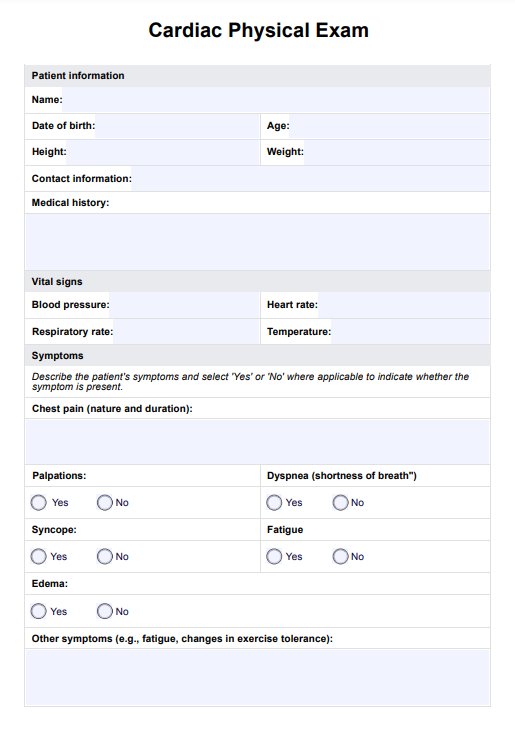Pediatric Physical Exam
Learn how a Pediatric Physical Exam how. Download a free template for your practice today.


The importance of regular pediatric tests for children
A Pediatric Physical Exam is essential for identifying and managing potential health concerns as a pediatric patient grows. Regular pediatric physical examinations allow healthcare professionals to track growth metrics, assess developmental milestones, and detect conditions that may otherwise go unnoticed (Miller Children's & Women's Hospital, 2023). A relatively complete physical examination ensures that vital signs, such as blood pressure, are monitored to identify early signs of hypertension or other systemic issues.
Additionally, screenings can reveal concerns unrelated to the primary visit, as an examination revealed findings unrelated to the child's presenting symptoms. A complete physical examination supports early detection of congenital conditions, nutritional deficiencies, and neurological disorders.
If the test is performed in a limited or inadequate examination type, critical health concerns may go undiagnosed, leading to delayed interventions. Consistent physical examination findings help establish a baseline for future assessments, ensuring that as a child's age advances, their health trajectory is carefully monitored for potentially life-threatening conditions.
Pediatric Physical Exam Template
Pediatric Physical Exam Example
What is a Pediatric Physical Exam?
A Pediatric Physical Exam is a systematic assessment used to evaluate a child's overall health, growth, and development. It serves as a valuable resource for identifying major concerns related to underlying medical conditions. A well-performed history combined with a thorough examination allows healthcare providers to detect significant conditions early. The exam includes assessing each body system, measuring vitals against normal values, and tracking progress using a growth chart as the child grows.
In small children, early identification of abnormalities is remarkably beneficial for timely intervention. The diagnostic process includes screenings for developmental delays, congenital disorders, and metabolic issues. A physical examination remains essential in ruling out conditions that could lead to a potentially life-threatening condition if left untreated. Numerous medical anecdotes highlight cases where routine exams led to the early detection of serious health issues, reinforcing their necessity in pediatric care.
Key components of a Pediatric Physical Exam
A Pediatric Physical Exam is a structured assessment aimed at evaluating a child’s overall health and development. It follows the general principles of clinical examination while focusing on age-specific concerns. Each assessment component provides critical information about the patient’s chief complaint, underlying significant conditions, and any abnormalities within specific organ systems.
A physical examination remains a key tool in early disease detection, ensuring the child’s well-being and guiding further diagnostic tests when needed. Below are the essential components of a pediatric physical examination, each discussed separately to highlight its importance.
Medical history
A thorough history taking is the foundation of a pediatric evaluation. It includes details about the patient’s chief complaint, past illnesses, allergies, medications, and significant conditions in family history. Dietary habits, physical activity, and environmental exposures are also considered. This information helps identify risk factors for chronic diseases and developmental delays.
Vital signs
Recording standard measurements such as temperature, blood pressure, heart rate, and respiratory rate is crucial for monitoring a child's physiological stability. Deviations from normal values may indicate underlying infections, cardiovascular issues, or metabolic disorders. Assessing skin color, hydration status, and oxygen saturation (SPO2) can provide additional insights into a child’s overall well-being.
Physical examination
The overall approach to a pediatric physical examination involves a structured assessment of specific organ systems to identify abnormalities. It begins with evaluating general appearance, including alertness, posture, and distress levels. Examination of the head, ears, nose, and throat checks for cranial abnormalities, infections, and hearing impairments.
The cardiovascular system is assessed for murmurs, irregular rhythms, and abnormal pulses, while the respiratory system is evaluated for breath sounds and breathing effort. The abdomen and viscera are palpated for tenderness or mass lesions, and the musculoskeletal system is examined for range of motion and strength. Lastly, the neurological system is tested for reflexes, sensory responses, and motor function. A complete physical examination is essential for early detection of health concerns.
Immunization and preventive care
Reviewing immunization records is a critical part of pediatric care. Ensuring that vaccines are up to date helps prevent serious infections. Preventive guidance on nutrition, injury prevention, and behavioral health is also provided. When necessary, screenings for anemia, lead exposure, or hearing and vision impairments are included to ensure comprehensive pediatric care.
How does it work?
Using Carepatron’s Pediatric Physical Exam template streamlines assessments for medical professionals, ensuring consistency and efficiency. The structured format allows for well-documented history taking, organized physical examination findings, and comprehensive patient tracking. Follow these steps to integrate the template into your workflow for accurate assessments and effective patient management.
Step 1: Access the assessment template
To begin, click “Use template” to access the Pediatric Physical Exam template. You will be directed to Carepatron’s platform, where you can download the app and seamlessly incorporate the template into your clinical practice. This ensures easy access to standardized assessments for every pediatric patient you evaluate.
Step 2: Use the template in patient assessment
Once the template is accessible, begin by recording patient information, including demographics, medical history, and current concerns. This structured format ensures that history taking is thorough, helping to identify significant conditions early. Standardized fields prevent missing critical details and allow for seamless documentation and retrieval.
Step 3: Conduct the examination
Perform a complete physical examination, following the template’s structured approach. Evaluate specific organ systems, record physical examination findings, and assess vitals such as respiratory rate and blood pressure. The template guides practitioners through general principles of pediatric assessment, ensuring consistency and reducing the risk of a limited or inadequate examination.
Step 4: Gather data
As you document findings, use the template to compare with normal values and track changes over time. The structured layout helps identify trends, such as abnormal growth patterns in the growth chart, or deviations in skin color that may indicate a significant condition. Comprehensive data collection aids the diagnostic process and clinical decision-making.
Step 5: Provide patient support and next steps
After the examination, use the template to outline major concerns, order necessary diagnostic tests, and provide preventive care recommendations. Document vaccination updates, developmental milestones, and any physical examination remain to be conducted at follow-up visits. The structured format ensures all essential aspects of pediatric care are covered for optimal patient well-being.
Benefit of using this exam
The Pediatric Physical Exam is one of the most important tools for medical professionals, ensuring thorough documentation and structured assessments. It standardizes diagnosis by providing a clear framework for evaluating infants, children, and those in adolescence. By consistently tracking head circumference, growth patterns, and vitals, clinicians can identify deviations from normal values and detect a significant condition early.
The template ensures that no physical examination remain incomplete, reducing the risk of missed diagnoses. In many instances, standardized documentation improves communication among healthcare providers and supports accurate referrals.
The structured approach helps integrate effective techniques for evaluating specific organ systems, streamlining workflows, and ensuring high-quality patient care. By using this exam, practitioners can optimize efficiency, reduce errors, and maintain comprehensive medical records, improving both short-term assessments and long-term patient monitoring.
References
Miller Children's & Women's Hospital. (2023). The importance of regular pediatric check-ups: A year-round guide. MemorialCare. https://www.millerchildrens.memorialcare.org/blog/importance-regular-pediatric-check-ups-year-round-guide
Commonly asked questions
A Pediatric Physical Exam involves a comprehensive assessment of a child’s growth, development, and overall health, including a review of medical history, vital signs, and a systematic physical examination of specific organ systems. It helps detect significant conditions, monitor milestones, and guide preventive care such as vaccinations and screenings.
General appearance includes observations of the child's alertness, posture, skin tone, and overall well-being. It provides critical clues about nutritional status, hydration, distress levels, and any visible abnormalities that may indicate an underlying significant condition.
Standard measurements include height, weight, head circumference for infants, blood pressure, respiratory rate, heart rate, and oxygen saturation. These values help track growth, assess development, and identify abnormalities requiring further evaluation.
A pediatric physical examination is recommended annually after age three, with more frequent visits during infancy to monitor early development and immunization schedules. High-risk children or those with existing medical conditions may require more frequent assessments.












































































































